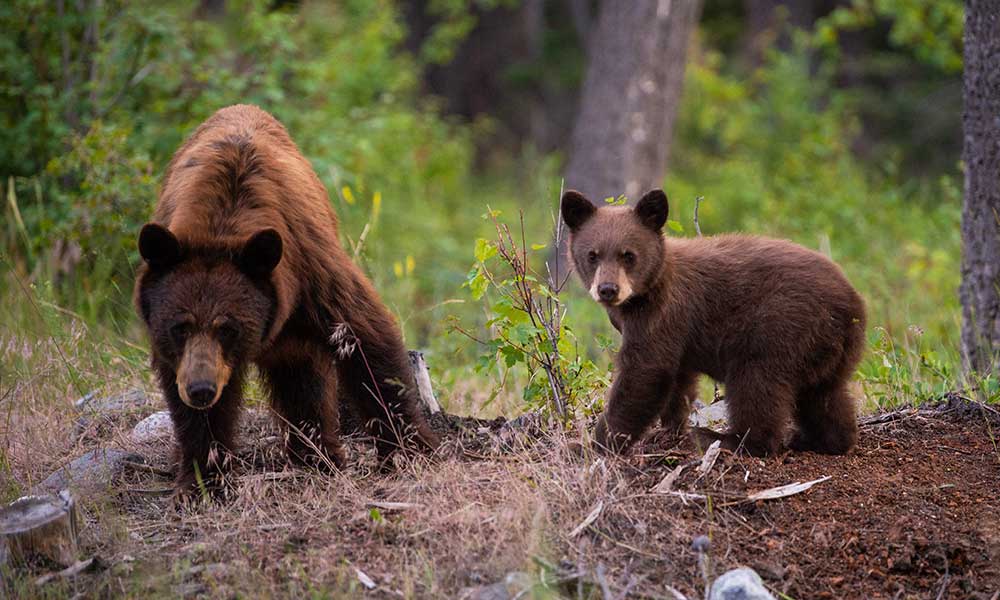Life isn’t a fairy-tale. If you stumble upon a bear den, you’re not going to find porridge cooked to varying temperatures and a family of slightly annoyed Ursidae. More than likely, the porridge will be off the menu and you’ll be on it.
So, how do you know if you stumble upon a bear den during your hike? What does it look like and what sort of signs should you be on the lookout for?
Let’s find out.
What is a Bear’s Den Like?
Bears hibernate in a variety of places, including hollow trees. Oftentimes, the den won’t be much bigger than the bear, allowing them to stay snug and conserve heat throughout the winter.
However, mature trees that have rotted enough to create a hollow trunk are hard to find. As a result, bears may look for den sites in the crevices of rocks or in caves. They are also known to dig into hillsides and root systems, although these den sites often collapse before they get a chance to use them, so they are rare.
As a last resort, a bear may simply bury itself in brush piles or fallen trees.
What Does a Grizzly Bear’s Den Look Like?
Grizzly dens aren’t too dissimilar from black bear dens. They look for safe and secure places to hide away, including caves, crevices, and hollow trees.
How to Spot a Bear Den
Bears are smart creatures. When they den, they are looking for somewhere safe and secure, somewhere that will protect them from the elements and from other animals (including humans). They will often look for den sites away from trails and other popular areas, although they have also been known to hibernate under porches and in outbuildings.
The bear will prepare its den in the summer months and then enter during the winter. Pregnant females will typically use this time to give birth and raise cubs before the mother bear emerges a few months later.
If you stumble upon a mother bear with young cubs, she will be even more aggressive and territorial. She will do everything to protect those cubs, and that’s bad news for you.
Most bears search for dens that make use of the natural surroundings, but they may also prepare the area by digging.
If you see signs of a disturbance, an opening leading into a crevice/cave, or a fallen tree that has a lot of claw marks, you may have stumbled upon a brown or black bear den.
You may also notice a lot of bear scat around the area, as well as hair and other signs of activity. Bear dens are not always as dirty and foul-smelling as you might expect, though.
When traveling in bear country during the winter months, keep your wits about you, don’t venture too far off the trail, and if you see an opening leading into a dark cave, remember that this is real life and not The Goonies! You’re more likely to find a grumpy bear than a hoard of treasure.
Winter trails are often closed if a bear den is discovered nearby. If you find one, report it.
Do Bears Go Back into the Same Den?
Bears rarely return to the same den. This is likely because many bear dens collapse when the ground thaws and the weather changes, though it will depend on the area.
Do Bears Make Nests?
You may see something that looks like a nest around the bottom of a tree, but this is likely just a result of a feeding bear. If the tree produces food that the bear eats, it will scale the tree, remove branches, and throw or carry them down. The tree branches will cluster around the bottom of the tree.
It might look like a bear nest, but it’s not. That doesn’t mean you’re in the clear, though, as it could indicate that a bear is near.
Do Bears Sleep?
Bears rarely sleep during the spring and summer. They spend most of these seasons wide awake and will hunt, gather, and feed as much as they can. When winter rolls around, they’ll prepare their den and then catch up on all that missed sleep by hibernating for most of the season.
Is a Bear Dangerous When it Emerges From its Den?
It’s often assumed that bears are hungry and grumpy when they emerge from their dens after hibernating. After all, they’ve been in there for a long time and have been deprived of food throughout that time.
But bears are not too dissimilar from you after you’ve been asleep for a long time. They are lethargic, tired, grumpy, and might look a little lost. That doesn’t mean that you can take them lightly, though, as they can still rip you to shreds.
Bears don’t hibernate in the same way as other animals. In fact, many experts refer to a bear’s hibernation as a “winter sleep” because while their heart rate, breathing, and body temperature drop, it doesn’t go too low. If you rouse a groundhog from its hibernation it may take some time to stir as it needs to bring its body temperature and heart rate back up. If you wake a bear, it’s more or less ready to go, albeit a little more lethargic than usual.
Do Bears Smell Bad?
Bears don’t smell as bad as you might think, so you can’t rely on your nose when you’re hiking through bear country.
Some people report being able to smell a bear before they see it, but this is usually because they have just feasted on rotten meat or have rolled around in it. They may also be smelling a carcass. Like most mammals, bears try their best to stay clean and will often groom themselves.







